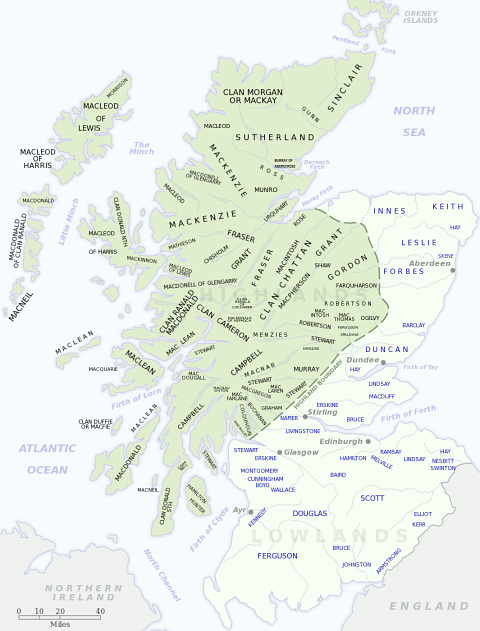
Motto: Pro rege (For the King)
Historic Seat: Dùn Eibhinn
District: Hebrides
Associated Surnames: Fee, MacAfee, MacDuffie, MacGuffie, MacHaffie, Macilvrae, MacPhee, Mahaffey
Associated Tartans:
Early MacFie Genealogy and History:
(Excerpt from "The Scottish Clans and Their Tartans", James Grant, 1906)
This clan is supposed to be a branch of the race of Alpine; the name is spelt in a variety of ways, Dubhsith in Gaelic has passed into Duffie in English, which in its MacDuffie form has further passed into MacFie, which is also spelt MacaFee, MacFee, and MacPhee, the name implying a dark-coloured tribe.
After the Norse occupation, Colonsay, in the county of Argyll, fell under the sway of the Lords of the Isles. In 1549 Archdeacon Munro informs us that "the Ile is brucket be ane gentle capitane callit MacDuffyhe, and pertained of auld to Clan Donald of Kintyre."1 The MacDuffies or MacPhees seem to have possesed the island for a considerable time. On the tombstones of Oronsay they figure as warriors and ecclesiastics. The island was held by the MacPhees as late as the middle of the seventeenth century; there are still several freeholders and many respectable families of the name in the county and elsewhere.
During the Civil War of 1645,2 Coll MacDonald, a companion of the Marquis of Montrose, was accused of having been guilty, with some of his followers, of the slaughter of Malcolm MacPhee of Colonsay. The clan having been dispossessed of its original inheritance became a "Broken Clan," lost its independence, and so was obliged to rank under more powerful clans; the greater part followed the MacDonalds of Islay, others settled in the country of the Camerons under Lochiel, where they were distinguished for their bravery; others found homes on both entrances to the Firth of Clyde, whilst others settled in the north of Ireland, where the name is spelt according to the primitive pronunciation, MacHaffie or MacAfee.
At the battle of Culloden,3 1745, the Camerons were one of the few clans who made that furious onset which nearly annihilated the left wing of the Duke of Cumberland's army, and almost led to a brilliant victory; the Camerons suffered severely, and with them a proportionate number of the MacFies, but soon loyalty to the reigning dynasty was in the ascendant, and the armorial bearings of the race have for motto the words Pro rege.
(End excerpt)
Next page: Clan MacGillivray
Footnotes:
1 the Ile is brucket be ane gentle capitane callit MacDuffyhe, and pertained of auld to Clan Donald of Kintyre: the Isle is under control of a gentle captain called MacDuffy, and belonged of old to Clan Donald of Kintyre
2 Civil War of 1645 Fought between Scottish Royalists - supporters of Charles I under James Graham, 1st Marquis of Montrose - and the Covenanters, who had controlled Scotland since 1639 and allied with the English Parliament. Read more about Scotland in the Wars of the Three Kingdoms at Wikpedia.
3 The Battle of Culloden (1746): The Battle of Culloden was fought on 16 April 1746, on Drummossie Moor, near Culloden, east of Inverness Scotland, between Scottish forces led by Charles Edward Stuart (Bonnie Prince Charlie) and English forces led by William Augustus, Duke of Cumberland. It was the final confrontation of the Jacobite rising of 1745. Read more about the Battle of Culloden at Wikipedia.

Distribution of Scottish clans and families
View larger map at Wikimedia Commons

Browse the Clan MacFie Tartan Collection with home decor, personal accessories, crafting, paper products, and more.

Clan MacFie Postcard: Digitally cleaned and enhanced vintage illustration with tartan border.